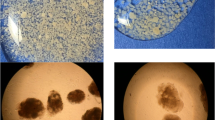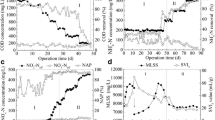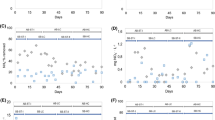Abstract
Two bubble column sequencing batch reactors fed with an artificial wastewater were operated at 20 °C, 30 °C, and 35 °C. In a first stage, stable granules were obtained at 20 °C, whereas fluffy structures were observed at 30 °C. Molecular analysis revealed high abundance of the operational taxonomic unit 208 (OTU 208) affiliating with filamentous bacteria Leptothrix spp. at 30 °C, an OTU much less abundant at 20 °C. The granular sludge obtained at 20 °C was used for the second stage during which one reactor was maintained at 20 °C and the second operated at 30 °C and 35 °C after prior gradual increase of temperature. Aerobic granular sludge with similar physical properties developed in both reactors but it had different nutrient elimination performances and microbial communities. At 20 °C, acetate was consumed during anaerobic feeding, and biological phosphorous removal was observed when Rhodocyclaceae-affiliating OTU 214 was present. At 30 °C and 35 °C, acetate was mainly consumed during aeration and phosphorous removal was insignificant. OTU 214 was almost absent but the Gammaproteobacteria-affiliating OTU 239 was more abundant than at 20 °C. Aerobic granular sludge at all temperatures contained abundantly the OTUs 224 and 289 affiliating with Sphingomonadaceae indicating that this bacterial family played an important role in maintaining stable granular structures.





Similar content being viewed by others
References
Altschul SF, Madden TL, Schäffer AA, Zhang J, Zhang Z, Miller W, Lipman DJ (1997) Gapped BLAST and PSI-BLAST: a new generation of protein database search programs. Nucleic Acids Res 25:3389–3402
Beun JJ, Heijnen JJ, van Loosdrecht MCM (2001) N-Removal in a granular sludge sequencing batch airlift reactor. Biotechnol Bioeng 75:82–92
Beun JJ, van Loosdrecht MCM, Heijnen JJ (2002) Aerobic granulation in a sequencing batch airlift reactor. Water Res 36:702–712
Bond PL, Keller J, Blackall LL (1998) Characterisation of enhanced biological phosphorous removal activated sludges with dissimilar phosphorous removal performances. Water Sci Technol 37:567–571
Cech J, Hartman P (1993) Competition between polyphosphate and polysaccharide accumulating bacteria in enhanced biological phosphate removal systems. Water Res 27:1219–1225
Crocetti GR, Hugenholtz P, Bond PL, Schuler A, Keller J, Jenkins D, Blackall LL (2000) Identification of polyphosphate-accumulating organisms and design of 16S rRNA-directed probes for their detection and quantitation. Appl Environ Microbiol 66:1175–1182
Crocetti GR, Banfield JF, Keller J, Bond PL, Blackall LL (2002) Glycogen-accumulating organisms in laboratory-scale and full-scale wastewater treatment processes. Microbiol 148:3353–3364
de Bruin LMM, de Kreuk MK, van der Roest HFR, Uijterlinde C, van Loosdrecht MCM (2004) Aerobic granular sludge technology: an alternative to activated sludge? Water Sci Technol 49:1–7
de Kreuk MK, van Loosdrecht MCM (2004) Selection of slow growing organisms as a means for improving aerobic granular sludge stability. Water Sci Technol 49:9–17
de Kreuk MK, Heijnen JJ, van Loosdrecht MCM (2005a) Simultaneous COD, nitrogen, and phosphate removal by aerobic granular sludge. Biotechnol Bioeng 90:761–769
de Kreuk MK, Pronk M, van Loosdrecht MCM (2005b) Formation of aerobic granules and conversion processes in an aerobic granular sludge reactor at moderate and low temperatures. Water Res 39:4476–4484
de Kreuk MK, Kishida N, van Loosdrecht MCM (2007) Aerobic granular sludge—state of the art. Water Sci Technol 55:75–81
Erdal UG, Erdal ZK, Randall CW (2003) The competition between PAOs (phosphorus accumulating organisms) and GAOs (glycogen accumulating organisms) in EBPR (enhanced biological phosphorus removal) systems at different temperatures and the effects on system performance. Water Sci Technol 47:1–8
Filipe CDM, Daigger GT, Grady CPL (2001) pH as a key factor in the competition between glycogen-accumulating organisms and phosphorus-accumulating organisms. Water Environ Res 73:223–232
Hesselmann RPX, Werlen C, Hahn D, van der Meer JR, Zehnder AJB (1999) Enrichment, phylogenetic analysis and detection of a bacterium that performs enhanced biological phosphate removal in activated sludge. Syst Appl Microbiol 22:454–465
Kortstee GJ, Appeldoorn KJ, Bonting CF, van Niel EW, van Veen HW (1994) Biology of polyphosphate-accumulating bacteria involved in enhanced biological phosphorous removal. FEMS Microbiol Rev 15:137–153
Legendre P, Legendre L (1998) Numerical ecology, 2nd English edition edn. Elsevier, Amsterdam
Liu Y, Liu QS (2006) Causes and control of filamentous growth in aerobic granular sludge sequencing batch reactors. Biotechnol Adv 24:115–127
Liu Y, Tay J-H (2004) State of the art of biogranulation technology for wastewater treatment. Biotechnol Adv 22:533–563
Lopez-Vazquez CM, Song YI, Hooijmans CM, Brdjanovic D, Moussa MS, Gijzen HJ, van Loosdrecht MMC (2007) Short-term temperature effects on the anaerobic metabolism of glycogen accumulating organisms. Biotechnol Bioeng 97:483–495
Maidak BL, Olsen GJ, Larsen N, Overbeek R, McCaughey MJ, Woese CR (1996) The Ribosomal Database Project (RDP). Nucleic Acids Res 24:82–85
Martins AMP, Pagilla K, Heijnen JJ, van Loosdrecht MCM (2004) Filamentous bulking sludge—a critical review. Water Res 38:793–817
Meyer RL, Saunders AM, Blackall LL (2006) Putative glycogen-accumulating organisms belonging to the Alphaproteobacteria identified through rRNA-based stable isotope probing. Microbiol 152:419–429
Morgenroth E, Sherden T, van Loosdrecht MCM, Heijnen JJ, Wilderer PA (1997) Aerobic granular sludge in a sequencing batch reactor. Water Res 31:3191–3194
Mosquera-Corral A, de Kreuk MK, Heijnen JJ, van Loosdrecht MCM (2005) Effects of oxygen concentration on N-removal in an aerobic granular sludge reactor. Water Res 39:2676–2686
Oehmen A, Yuan Z, Blackall LL, Keller J (2004) Short-term effects of carbon source on the competition of polyphosphate accumulating organisms and glycogen accumulating organisms. Water Sci Technol 50:139–144
Panswad T, Doungchai A, Anotai J (2003) Temperature effect on microbial community of enhanced biological phosphorus removal system. Water Res 37:409–415
Rosselló-Mora RA, Wagner M, Amann R, Schleifer KH (1995) The abundance of Zoogloea ramigera in sewage treatment plants. Appl Environ Microbiol 61:702–707
Satoh H, Mino T, Matsuo T (1994) Deterioration of enhanced biological phosphorous removal by the domination of micro-organisms without polyphosphate accumulation. Water Sci Technol 30:203–211
Saunders AM, Oehmen A, Blackall LL, Yuan Z, Keller J (2003) The effect of GAOs (glycogen accumulating organisms) on anaerobic carbon requirements in full-scale Australian EBPR (enhanced biological phosphorus removal) plants. Water Sci Technol 47:37–43
Tay STL, Zhuang WQ, Tay JH (2005) Start-up, microbial community analysis and formation of aerobic granules in a tert-butyl alcohol degrading sequencing batch reactor. Environ Sci Technol 39:5774–5780
Whang LM, Park JK (2002) Competition between polyphosphate- and glycogen-accumulating organisms in biological phosphorus removal systems—effect of temperature. Water Sci Technol 46:191–194
Whang LM, Park JK (2006) Competition between polyphosphate- and glycogen-accumulating organisms in enhanced-biological-phosphorus-removal systems: effect of temperature and sludge age. Water Environ Res 78:4–11
Wilen B-M, Onuki M, Hermansson M, Lumley D, Mino T (2008) Microbial community structure in activated sludge floc analysed by fluorescence in situ hybridization and its relation to floc stability. Water Res 42:2300–2308
Williams JC, Reyes FLD (2006) Microbial community structure of activated sludge during aerobic granulation in an annular gap bioreactor. Water Sci Technol 54:139–146
Zitomer DH, Duran M, Albert R, Guven E (2007) Thermophilic aerobic granular biomass for enhanced settleability. Water Res 41:819–825
Acknowledgments
The authors thank Marc Deront and Jean-Pierre Kradolfer for the excellent technical assistance in the reactor construction and operation, respectively.
Author information
Authors and Affiliations
Corresponding author
Electronic supplementary material
Below is the link to the electronic supplementary material.
ESM 1
(DOC 81 kb)
Rights and permissions
About this article
Cite this article
Ebrahimi, S., Gabus, S., Rohrbach-Brandt, E. et al. Performance and microbial community composition dynamics of aerobic granular sludge from sequencing batch bubble column reactors operated at 20 °C, 30 °C, and 35 °C. Appl Microbiol Biotechnol 87, 1555–1568 (2010). https://doi.org/10.1007/s00253-010-2621-4
Received:
Revised:
Accepted:
Published:
Issue Date:
DOI: https://doi.org/10.1007/s00253-010-2621-4




